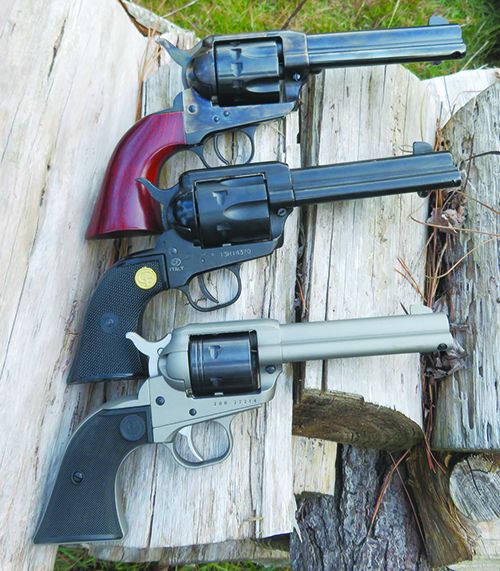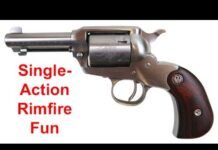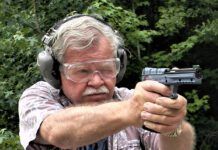If we were to put together a list of top plinking pistols, we would have to put single-action rimfires at the top of that list. The ammo cost is low, recoil is nil, and muzzle blast is tolerable, especially for new shooters. To see which of three single-action wheelguns hit the tin can for us, we assembled three rimfire revolvers that spanned a sizable price range and size. We started at the low end with a Cimarron Plinkerton, followed that with a new Ruger Wrangler, and capped the cost level at the high end with an Uberti Cattleman 22. Size-wise, the Uberti is a full-size pistol, the Cimarron is scaled down, and the Ruger the smallest of the bunch.
All of these revolvers had similar barrel lengths and traditional sights, consisting of a front blade and notch or groove rear sight. If we were to buy on looks alone, the Uberti would come out ahead. It is hard to beat a smooth, well-fitted walnut grip, case colors, and deep bluing. The Ruger and Cimarron were a bit rough on fit and finish, but tolerable due to their respective prices and performance.
We found all three of these single-action rimfires performed well, and we especially liked the free-rotating cylinder of the Ruger and the large loading gates on the Uberti and Cimarron. We had no issues with any of these revolvers. We fired a lot of 22 LR ammo, and the most we experienced were sticky empties, but the ejector rod made those easy to unload.
How We Tested
| Remington Thunderbolt 22 Long Rifle 40-grain RNS | Cimarron Pinkerton | Uberti v | Ruger Wrangler |
| Average Velocity | 1026 fps | 945 fps | 930 fps |
| Muzzle Energy | 94 ft.-lbs. | 79 ft.-lbs. | 77 ft.-lbs. |
| Smallest Group | 0.80 in. | 0.89 in. | 0.78 in. |
| Average Group | 0.86 in. | 0.98 in. | 1.06 in. |
| PMC Target 22 Long Rifle 40-grain RNS | Cimarron Pinkerton | Uberti v | Ruger Wrangler |
| Average Velocity | 946 fps | 844 fps | 845 fps |
| Muzzle Energy | 79 ft.-lbs. | 63 ft.-lbs. | 63 ft.-lbs. |
| Smallest Group | 0.72 in. | 0.80 in. | 0.88 in. |
| Average Group | 0.87 in. | 0.90 in. | 1.03 in. |
| CCI Mini-Mag 22 Long Rifle 36-grain HP | Cimarron Pinkerton | Uberti v | Ruger Wrangler |
| Average Velocity | 837 fps | 811 fps | 809 fps |
| Muzzle Energy | 78 ft.-lbs. | 76 ft.-lbs. | 75 ft.-lbs. |
| Smallest Group | 0.70 in. | 0.73 in. | 1.06 in. |
| Average Group | 0.87 in. | 0.86 in. | 1.19 in. |
| Federal Game Shot 22 Long Rifle #12 Shot | Cimarron Pinkerton | Uberti v | Ruger Wrangler |
| Pattern Size | 11.0 in. | 11.2 in. | 12.2 in. |
We tested a variety of 22 LR ammunition, including inexpensive Remington Thunderbolt, PMC Target, and CCI Mini Mag. All of these cartridges offered a range of velocities so we could better understand what brand of ammo these smallbores preferred. We used our range bag as a rest and fired at targets set at 15 yards. We also used Federal Game Shot cartridges. While these revolvers make great plinkers, they also are good for dispatching snakes. In fact, the Ruger helped dispose of a fat copperhead squatting on the patio of one of the testers. A blast of the #12 shot at 5 feet sent the viper to snake heaven. We tested the shot cartridge at 10 yards. In the end, we liked all three rimfires; what determined the final grade was fit and finish, shooting to point of aim, and cost. Here’s what we determined.
Cimarron Plinkerton ASPLINK1 22 LR, $172
GUN TESTS GRADE: B
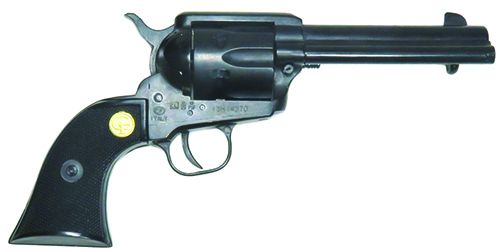
| Action | Revolver, single action |
| Overall Length | 10.0 in. |
| Overall Height | 5.25 in. |
| Maximum Width | 1.6 in. |
| Weight Unloaded | 33.0 oz. |
| Weight Loaded | 36.6 oz. |
| Cylinder Gap | 0.008 in. |
| Barrel Length | 4.75 in. |
| Capacity | 6 |
| Frame Material/Finish | Zamak alloy/matte black |
| Cylinder Material/Finish | Steel/matte black |
| Frame Front Strap Height | 2.1 in. |
| Frame Back Strap Height | 3.0 in. |
| Grips | Checkered plastic |
| Grip Thickness (max) | 1.5 in. |
| Grip Circumference (max) | 5.7 in. |
| Front Sight | Ramp blade |
| Rear Sight | Fixed notch |
| Sight Radius | 5.5 in. |
| Trigger-Pull Weight | 2.5 lbs. |
| Trigger Span | 2.8 in. |
| Safety | Key-activated gun lock |
| Warranty | 1 year |
| Telephone | (877) 749-4861 |
| Website | Cimarron-Firearms.com |
| Made In | Italy |
This was a pre-shutdown price at BudsGunShop.com. The Cimarron Plinkerton is inexpensive and looked it. This model is actually discontinued by Cimarron, but it is available from Chiappa Firearms. The Plinkerton and the Chiappa 1873 SAA 22 are virtually the same revolver. Both are manufactured by Chiappa in Italy.
The barrel and fluted cylinder were made of steel. The frame, one-piece grip frame, and barrel sleeve were made of Zamak alloy, which is a combination of zinc and aluminum. The finish on the cylinder did not match the finish on the rest of the revolver. The finish looked thin.
Another complaint were the two-piece grips. They were well fitted to the grip strap, but the area where the grip and the frame met was sloppy. The plastic grip panels protruded above the surface of the frame about 0.125 inches, and because this is the area where the user grips the revolver, it can rub the skin during recoil. Albeit the recoil isn’t much with a 22 LR, but the repetition of extended shooting can wear on the user’s trigger finger.
Besides those two well-deserved gripes, the Plinkerton has nice heft and is similar in weight to a centerfire revolver. In fact it looks like a standard six-shooter. The grip was slightly smaller than a traditional centerfire. We thought the grip worked fine except for the aforementioned grip panels.
The action had three distinct clicks when the shooter thumbed back the hammer. The hammer needs to be on half cock to rotate the cylinder to load or unload. The loading gate was sized for a centerfire cartridge, so there was plenty of room to load the tiny 22 LR cartridges in one of the six chambers. The chambers were not countersunk. Because the cylinder is designed for a longer centerfire cartridge, the 22 LR bullets need to leap about 0.7 inches before entering the forcing cone. We expected some splatter, but did not experience any during live fire.
The firing pin is fixed into the frame, and there is no transfer bar. Do not carry this revolver with a live round chambered under the hammer and firing pin.
The hammer at full cock came back quite far. A large-handed user might get the web of his hand pinched between the hammer and backstrap, but we had no issues. The hammer had good checkering on the spur, but the edge was a bit sharp. We’d take a file to this if we owned the gun and refinish the repair with a black Sharpie pen. The hammer was easy to cock, and the cylinder indexed and rotated like a traditional centerfire six-shooter.
While the Plinkerton operated similar to a traditional SAA, it did have a unique safety lock that blocks the hammer from contacting the firing pin. A key is required to rotate the safety in place. When locked, the revolver can be loaded and unloaded and the hammer snapped, but it will not contact the firing pin. You might want to use this lock when storing the revolver.
Also similar to a traditional single action is the skinny trigger. It had creep before it broke at 2.5 pounds, on average. We liked the pull weight and know that it contributed to our accuracy data results. The ejector rod head was a traditional crescent-shaped piece and rotated away from the barrel so your finger doesn’t get scorched when reloading after extending firing.
The sights consisted of a blade front and a notch in the top strap of the frame.
To field-strip the Plinkerton, place the hammer on half cock, open the loading gate, and push the base pin button while pulling out the cylinder rod. The cylinder then falls out of the loading gate side of the frame. The cylinder had a removable bushing like a traditional centerfire single action.
At the range we started thumbing and squeezing with inexpensive 40-grain Remington Thunderbolt ammo, and we were rewarded with a best five-shot group that measured 0.8 inches. The best groups became progressively smaller with the 40-grain PMC Target ammo (0.72 inches), and the 36-grain CCI Mini-Mags (0.70 inches). On average, all ammo grouped under an inch. That’s the good news. The bad news is the Plinkerton shot low and to the left. We needed to use some Kentucky windage and elevation to center our shots on the target. You could take a file to the front blade to adjust the elevation, and for the windage bend the blade. Our fear is the the Plinkerton’s die-cast metal could be brittle and easily break, and we wouldn’t do it. Don’t blame us if you break your sight. The shot load gave us an 11-inch off-center pattern at 10 yards.
When unloading, we needed to use the ejector rod on all chambers. The dry lubricant on 22 LR bullets gunk up the chambers, so the cases do not fall free. The cylinder had plenty of back-and-forth rotation, and we looked at the front of cylinder to line up the ejector rod with the front of the chamber. We noticed the ejector rod housing was not exactly flush with the side of the barrel. We could see light between the barrel and housing.
Our Team Said: The Plinkerton was fun to shoot and offered all we expected in a rimfire single-action revolver. We did not care for the rough-fitting grip panels and thin-looking finish. We also did not like that it did not shoot to point of aim, but it was accurate. The price was reasonable, but in this case, you get what you pay for.
Ruger Wrangler 2003 22 LR, $210
GUN TESTS GRADE: A
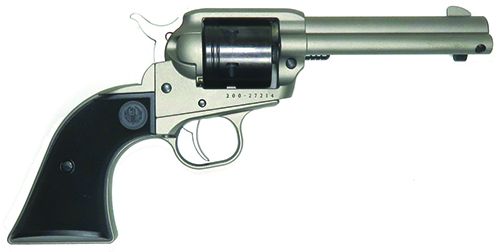
| Action | Revolver, single action |
| Overall Length | 10.25 in. |
| Overall Height | 5.0 in. |
| Maximum Width | 1.4 in. |
| Weight Unloaded | 30.0 oz. |
| Weight Loaded | 33.6 oz. |
| Cylinder Gap | 0.007 in. |
| Barrel Length | 4.62 in. |
| Capacity | 6 |
| Frame Material/Finish | Aluminum/zinc alloy/silver Cerakote |
| Cylinder Material/Finish | Steel/blued |
| Frame Front Strap Height | 2.1 in. |
| Frame Back Strap Height | 3.0 in. |
| Grips | Checkered black plastic |
| Grip Thickness (max) | 1.3 in. |
| Grip Circumference (max) | 6.0 in. |
| Front sight | Ramp blade |
| Rear Sight | Fixed notch |
| Sight Radius | 5.25 in. |
| Trigger Pull Weight | 4.8 lbs. |
| Trigger Span | 3.0 in. |
| Safety | None |
| Warranty | None written |
| Telephone | (336) 949-5200 |
| Website | Ruger.com |
| Made In | USA |
This was also a BudsGunShop.com price prior to the lockdowns. We think old man Ruger would have been delighted with the manufacturing cost savings — which translates to less cost to the user — of the Wrangler because one of his company’s flagship products is the rimfire Single-Six. He may have also cussed up and down over the finish quality on the grip frame. Just to set the level, the Wrangler is an inexpensive brother to the Single-Six — less than half the cost — and like we’ve said earlier, you get what you pay for.
The construction of the Wrangler uses zinc and aluminum alloy to keep the tiny handgun’s weight and price to a minimum. The frame is machined from cast-aluminum alloy. The barrel and cylinder are made from steel. The grip frame is cast from a zinc alloy. This makes the revolver lightweight. In fact, we dropped it in our back pocket and took it for our morning walk in the woods with the dog. It travels well and makes an ideal trail gun. The checkered hammer and smooth-faced trigger are both MIM (metal-injected molding) stainless-steel parts. Ruger finishes the Wrangler with a Cerakote finish that allows the exterior to appear the same no matter what the metal type, unlike the Cimarron. Our model had a silver Cerakote frame, barrel, and grip frame. Other colors are available. The cylinder, cylinder pin, base pin button and ejector head have a blued-black finish. The cylinder is unfluted and has two decorative lines milled at the rear of the cylinder. The two-piece grips are black checkered plastic that slightly overlapped the frame. At the butt, we noticed rough finishing. You can actually see the mold marks were not completely smoothed and the Cerakote was used to fill the gaps. Poor work from Ruger to say the least, but remember — you get what you pay for.
The barrel length is 4.625 inches, and the sights consist of a wide front blade and wide notch molded into the frame topstrap. We liked these sights.
Unlike the traditional single-action operation, the Wrangler allows the user to open the loading gate and spin the cylinder without having to thumb back the hammer to half cock. The six-shot cylinder is also free wheeling, so it rotates both clockwise and counterclockwise, making loading and unloading faster. There’s no need to rotate fully around to load a missed chamber like with the Uberti and Cimarron. We like this feature a lot because it is easy to rotate past the chamber when loading or unloading. The downside of this type of cylinder is that it may not automatically re-engage the cylinder latch if it’s rotated a little too far either way after the loading gate is closed. We found the hammer felt stuck and the cylinder didn’t rotate because the cylinder latch catch was not engaged with cylinder notch. Solution: Just rotate the cylinder until you hear a click to engage the latch into the notch for proper alignment, and now you are ready to fire.
Ruger also incorporates its transfer-bar safety mechanism, plus a loading gate interlock. With the loading gate open, the revolver cannot be cocked or fired. We like these safety features. You can carry the Wrangler full loaded because of the transfer-bar system.
The chambers are countersunk, so you need to make sure the cartridges are fully seated in the chamber. We did note that the loading gate was small so there was not a lot of room for fat fingers. The loading gate was also a bit stiff to open but loosened up with use. The frame is smaller than either of the other two guns tested. The grip is the same size as the Single-Six. While this gun weighs less, it does have nice balance in hand.
The wide Ruger-style trigger broke at 4.8 pounds on average. We would have liked it a pound lighter. The bullet has about 0.3 inches of chamber length before reaching the forcing cone. The Wrangler’s point of aim was dead on, which really endeared us to this revolver, however, we did note in the range data the accuracy did not match the Uberti nor the Cimarron. The best five-shot group we fired was with inexpensive 40-grain Remington Thunderbolt ammo that measured 0.78 inches. On average and with all ammo types, the Ruger averaged a little over 1-inch groups. This is still very darn acceptable for a dedicated plinker. The shot load gave us a 12-inch pattern.
The ejector rod head was tiny, and it did not rotate away from the barrel so your finger could get burned when reloading after extending firing. It field-stripped with fewer steps than a traditional wheelgun. Open the loading gate, push the base pin button, and pull out the cylinder rod. The cylinder then falls out of the loading gate side of the frame.
Our Team Said: The Wrangler is inexpensive and offers all the proven safety features of Ruger’s rimfire revolvers. It also shot to point of aim and was lightweight. This would make a good starter gun for a small newbie shooter. If they drop it and scratch, who cares? The craftsmanship on the butt is a big miss in our opinion, but we think for the price, the Wrangler will find its way into many camping, hiking, and fishing kits.
Uberti Cattleman 22 356186 22 LR, $453
GUN TESTS GRADE: A
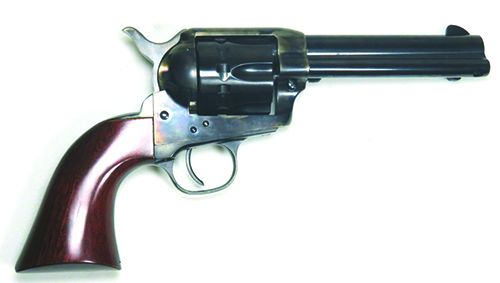
| Action | Revolver, single action |
| Overall Length | 10.0 in. |
| Overall Height | 5.25 in. |
| Maximum Width | 1.6 in. |
| Weight Unloaded | 36.8 oz. |
| Weight Loaded | 44.0 oz. |
| Cylinder Gap | 0.007 in. |
| Barrel Length | 4.75 in. |
| Capacity | 12 |
| Frame Material/Finish | Steel/casehardened, blued |
| Cylinder Material/Finish | Steel/blued |
| Frame Front Strap Height | 2.1 in. |
| Frame Back Strap Height | 3.0 in. |
| Grips | Smooth walnut |
| Grip Thickness (max) | 1.5 in. |
| Grip Circumference (max) | 6.0 in. |
| Front Sight | Ramp blade |
| Rear Sight | Fixed notch |
| Sight Radius | 5.75 in. |
| Trigger-Pull Weight | 3.3 lbs. |
| Trigger Span | 2.8 in. |
| Safety | None |
| Warranty | 5-year limited |
| Telephone | (800) 264-4962 |
| Website | Uberti-USA.com |
| Made In | Italy |
This was also a recent pre-Covid price at BudsGunShop.com. The Cattleman 22 is a traditionally styled revolver with all the heft of centerfire single action. Unlike the other rimfires tested, which have a six-round capacity, the Cattleman 22 has a 12-round capacity. At first glance, it looks like a centerfire revolver, but what gives it away are the extra bolt notches in the cylinder. Those extra bolt notches and six flutes give the Uberti a slightly unbalanced look. When the Uberti is cocked, you expect the cylinder to rotate more, but because this is a 12-shooter, the cylinder indexes slightly each time the hammer is cocked. We also noticed the front-sight blade is not as tall as the blade on a centerfire model.
The operation of this Uberti follows the same operation as a traditional single action, except there are only two clicks when the hammer is cocked, not three clicks. The hammer needs to be at half cock to rotate the cylinder. Because the Uberti is based on the full-size centerfire model, the loading gate gives you ample access to two chambers at a time. There is also plenty of room for fingers to push the cartridges into the chambers, which are countersunk.
There are a few other differences in this Uberti. First, there is no removable cylinder bushing. We also noticed a small firing-pin-sized notch machined into the recessed chambers. This notch allows the gun to be dry-fired without damage to the firing pin or cylinder. We thought this was a nice touch, but we still suggest you use either spent cases or 22 snap caps if you dry-fire a lot.
The fit and finish were nicely executed. The bluing was deep and nicely polished. The case colors were not the brilliant colors we’ve seen on Uberti’s centerfire revolvers. They were mostly grays and blue. The grip frame and main frame are fitted nicely, and the one-piece walnut grips have a light varnish and are well fitted to the frame and grip frame. The grip is full size on the Cattleman 22, not scaled down like on the other two revolvers.
Like the Cimarron, the Uberti has a manual lock safety. The Uberti uses the cylinder base pin, which has two notches around the muzzle end of the cylinder base pin. The rearward notch allows the hammer to fully fall. To use the safety notch on the pin, depress the latch button and push the cylinder base pin into the frame until you hear a click. That means the second notch is engaged and blocks the hammer from falling completely forward. This is a good idea when storing the revolver. You still need to carry the Uberti cowboy style, with the hammer resting on an empty chamber. We actually found that difficult to do because the chambers are inset, and you can’t see the cartridge rims from the outside the cylinder. We resorted to counting clicks rather when rotating the cylinder. The bullet has about 0.6 inch of chamber length before it reaches the forcing cone and barrel. We got no splatter.
Going hot, we found the front blade and rear notch are both wide enough to actually see them well. The trigger pull broke at 3.3 pounds on average with a very slight creep. Loading and ejection were easy because the Cattleman 22 indexed the chambers with the loading gate in the frame.
After thumbing back the hammer and squeezing the trigger, we found the Cattleman 22 gave us just under 1-inch five-shot groups. Many holes piled up onto each other. It shot to point of aim. Our best group was with 36-grain CCI Mini-Mags at 0.73 inches. The shot load gave us an 11.2-inch pattern at 10 yards. Use of the ejector rod was required to eject empty brass on all chambers. The ejector-rod head was crescent shaped and rotated away from the barrel when ejecting empties, so there were no singed fingertips from a hot barrel. The back edge of the hammer was rounded, and the checkering on the hammer allowed for easy cocking. The Cattleman 22 also field-stripped like a traditional single action.
Our Team Said: The Cattleman 22 offers twice the plinking fun because it is a 12-shooter. Well made and carrying the heft of a centerfire revolver, this might not be the best choice for a small, newbie shooter. This is an adult 22. You will be toting some heavy iron if you are looking for a trail gun. The price reflected the time and effort in the finished product.
Special thanks to Eastern Outfitters (EasternOutfitter.com) of Hampstead, NC, for their assistance.
Written and photographed by Robert Sadowski, using evaluations from Gun Tests team testers.

























